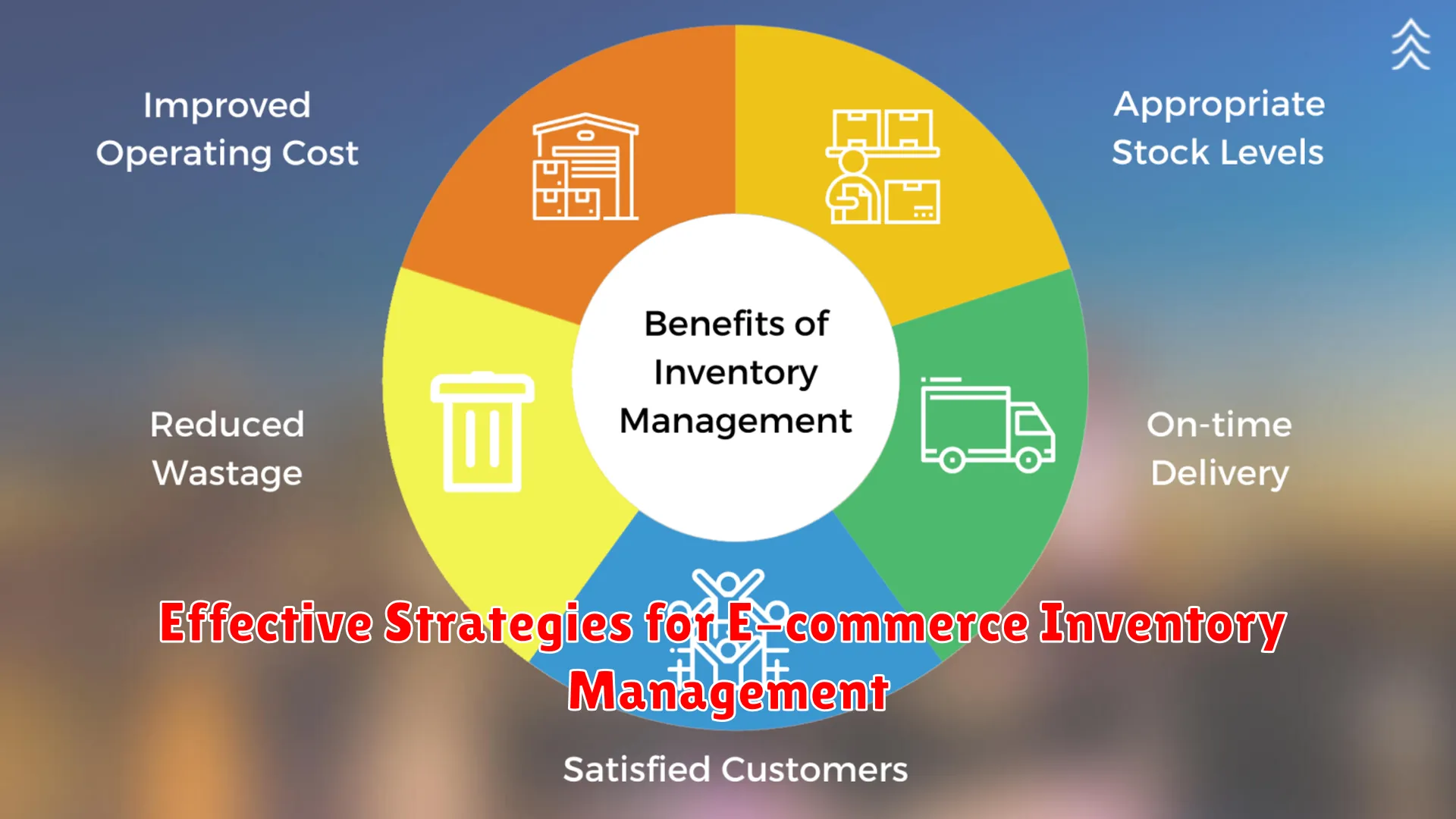Learn how to optimize your e-commerce inventory management with these effective strategies. From demand forecasting to supplier relationships, discover key tactics to streamline your operations and boost sales.
The Importance of Inventory Management

Effective inventory management is a crucial aspect of running a successful e-commerce business. When it comes to online retail, having a well-organized and optimized inventory system can make a significant impact on various areas of your operations and overall business performance.
1. Operational Efficiency: Proper inventory management ensures that you have the right products available at the right time. This helps to prevent stockouts and overstock situations, leading to streamlined operations and improved order fulfillment processes.
2. Customer Satisfaction: Maintaining an accurate inventory can enhance the customer experience by ensuring that items are in stock and can be delivered promptly. This leads to higher customer satisfaction levels and repeat business.
3. Cost Control: By managing inventory effectively, you can minimize holding costs, reduce the risk of dead stock, and optimize cash flow. This allows you to invest in other areas of your e-commerce business for growth and expansion.
4. Data-Driven Decision Making: Inventory management provides valuable data insights that can be used to forecast demand, track sales trends, and make informed decisions about purchasing, pricing, and promotions.
5. Competitive Advantage: A well-managed inventory system can give your e-commerce business a competitive edge in the market. Timely and accurate product availability can help you outperform competitors and capture a larger share of the market.
Techniques for Accurate Inventory Tracking

Accurate inventory tracking is vital for effective e-commerce inventory management. Utilizing the right techniques can help businesses streamline their operations and ensure that stock levels are always optimal. Here are some techniques to improve inventory tracking:
- Utilize Barcoding Systems: Implementing barcoding systems can help automate inventory tracking and minimize human error. Barcodes can be scanned quickly and accurately to update stock levels in real-time.
- Implement RFID Technology: Radio-frequency identification (RFID) technology enables businesses to track inventory more efficiently by using radio waves to identify and locate items. RFID tags can provide real-time data on stock movements.
- Regular Cycle Counts: Conducting regular cycle counts involves counting a portion of inventory on a rotating basis. This technique can help identify discrepancies and discrepancies quickly, allowing for prompt adjustments to inventory records.
- Utilize Inventory Management Software: Investing in inventory management software can centralize inventory tracking processes and provide real-time insights into stock levels, orders, and forecasts.
- Implement ABC Analysis: Prioritize inventory items based on their value and sales volume through ABC analysis. Classifying items as A, B, or C can help businesses focus on managing high-value items more efficiently.
- Implement Just-in-Time (JIT) Inventory: JIT inventory practices involve ordering and receiving goods only when needed. By implementing JIT inventory, businesses can reduce excess stockholding and improve inventory turnover rates.
- Utilize Cross-Docking: Cross-docking involves unloading incoming goods and loading them directly onto outbound vehicles with minimal storage time. This technique can help streamline inventory movement and reduce handling costs.
Balancing Stock Levels and Demand

Effective inventory management in e-commerce relies heavily on the precise balance between maintaining optimal stock levels and meeting customer demand. This delicate equilibrium can significantly impact the success and profitability of an online store.
One key strategy to achieve this balance is by utilizing data analytics and forecasting tools. By analyzing past sales trends and predicting future demand, e-commerce retailers can make informed decisions on stock replenishment and inventory adjustments.
Implementing a just-in-time inventory system can also help in managing stock levels efficiently. This approach minimizes excess inventory and reduces storage costs, while ensuring products are available when customers place orders.
Furthermore, establishing clear communication channels with suppliers and maintaining good relationships with them is crucial. Timely updates on stock levels, delivery schedules, and product availability enable e-commerce businesses to react promptly to fluctuations in demand.
Regularly reviewing and optimizing stock levels based on market trends, seasonal changes, and customer preferences is essential for staying competitive in the e-commerce landscape. Being adaptable and responsive to shifts in demand can help prevent stockouts or overstock situations.
Utilizing Technology for Inventory Optimization

In the realm of e-commerce inventory management, leveraging technology is crucial for optimizing operations and enhancing overall efficiency. One effective strategy that has been gaining traction among businesses is the utilization of advanced inventory management software and systems. These innovative tools provide real-time insights into inventory levels, order fulfillment, and demand forecasting, enabling e-commerce companies to make data-driven decisions and streamline their supply chain processes.
By integrating technology solutions like automated inventory tracking systems and barcode scanning technology, e-commerce businesses can improve inventory accuracy, reduce stockouts, and minimize carrying costs. These tools help in maintaining optimal inventory levels, preventing overstocking or understocking issues, and ultimately enhancing customer satisfaction through timely and accurate order fulfillment.
Furthermore, predictive analytics and machine learning algorithms play a crucial role in inventory optimization by analyzing historical data, predicting future demand trends, and identifying potential stock shortages. By leveraging these advanced technologies, e-commerce companies can proactively adjust their inventory levels, optimize warehouse operations, and minimize excess inventory holding costs.
In addition to software solutions, emerging technologies such as Internet of Things (IoT) devices and cloud-based platforms are revolutionizing e-commerce inventory management. IoT sensors allow real-time monitoring of inventory movement and storage conditions, while cloud-based systems provide scalability, flexibility, and accessibility for managing inventory across multiple channels and locations.
The Impact of Inventory Management on Customer Satisfaction

When it comes to running a successful e-commerce business, effective inventory management plays a crucial role in shaping customer satisfaction. The way a company handles its inventory can directly impact how satisfied customers are with their shopping experience.
Timely Order Fulfillment: One of the key impacts of efficient inventory management is the ability to ensure timely order fulfillment. When customers place an order, they expect their products to be delivered promptly. Smooth inventory management processes help in fulfilling orders quickly, leading to satisfied customers who are more likely to return for future purchases.
Product Availability: Maintaining optimal inventory levels ensures that products are always available for purchase. Nothing disappoints customers more than finding out that a product they want is out of stock. By effectively managing inventory, e-commerce businesses can avoid stockouts and provide a seamless shopping experience.
Accurate Product Information: Inventory management systems also contribute to accurate product information. Customers rely on accurate stock levels and product descriptions when making purchasing decisions. A well-maintained inventory system can prevent any discrepancies in product availability, leading to higher customer satisfaction.
Improved Customer Service: Efficient inventory management enables businesses to provide better customer service. With real-time stock updates and streamlined fulfillment processes, businesses can address customer inquiries promptly and accurately. This level of responsiveness enhances customer satisfaction and loyalty.
Conclusion
Implementing efficient inventory management techniques is crucial for e-commerce success, ensure optimized stock levels, reduce costs, and enhance customer satisfaction.

